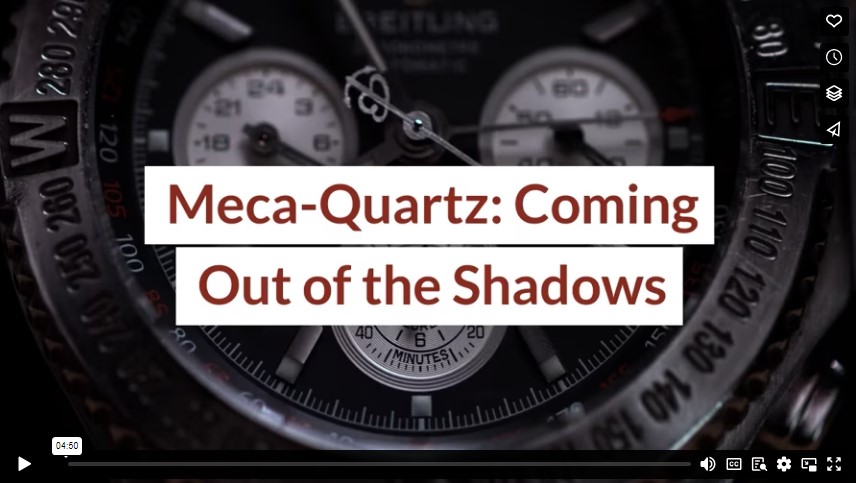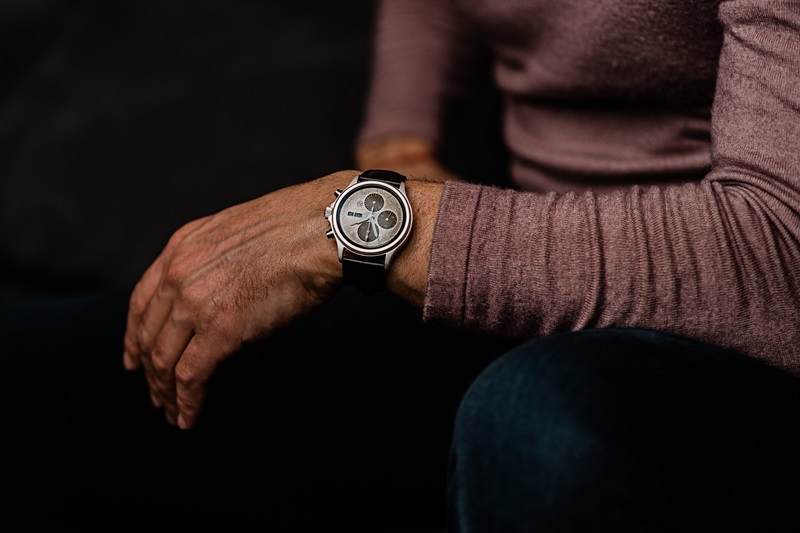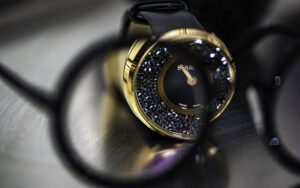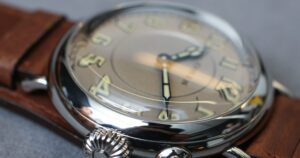Some would say meca-quartz (also spelled mecha-quartz) is the best-kept secret in affordable, high-quality chronographs. Others, like mechanical purists, think it’s a cheap imitation of the real thing. Either way, meca-quartz movements have made their way back into high-end watchmaking, and it looks like they’re here to stay.

What Exactly Is Meca-Quartz?
As the name implies, a meca-quartz movement blends a mechanical chronograph’s technical functionality with the quartz oscillator’s power and accuracy. While it is not the only hybrid mechanical-quartz creation in the history of Swiss and Japanese watchmaking (the Grand Seiko Spring Drive comes to mind), it is by far one of the least expensive adaptations.
In a traditional mechanical chronograph, winding the mainspring generates the energy to power the watch, while the balance wheel regulates that energy so it’s uniformly distributed throughout the movement. Various gears, levers, and hammers then use that power to operate the chronograph.
A meca-quartz chronograph, on the other hand, supplies power to the watch through a battery and dual quartz crystals. The first crystal regulates the time, while the second drives the mechanical chronograph parts.
Coming Around Again
Meca-quartz’s origins go back to the late 1980s when the Quartz Crisis was ravaging the world of mechanical watchmaking. To stay relevant and compete with emerging automatic chronographs like the Zenith El Primero, Swiss watchmakers Jaeger-LeCoultre and Frédéric Piguet decided to mix mechanical prowess with quartz technology to create a revolutionary new hybrid movement—the meca-quartz.
The JLC chronograph Calibre 630 and Piguet’s Calibre 1271 were beautifully decorated movements with Côtes de Genève and other high-end finishes. While the essential DNA of the watch was quartz and only the chrono was mechanical, the two companies wanted to make sure these timepieces lived up to the expert craftsmanship expected of an haute horlogerie marque.
Throughout the 1990s, other megawatt Swiss luxury brands like Breitling, Omega, IWC, Porsche Design, and Bulgari used the JLC and Piguet calibres to create their own lower-priced chronographs. By the 2000s, however, most Swiss watchmakers had returned to making only mechanical models, as these were beginning to experience a renaissance among buyers and collectors.
It would fall to Seiko to once again innovate and fill the gap between exorbitantly-priced complete mechanical chronographs and their significantly less expensive all-quartz counterparts. And it did, creating its own hybrid movement, the Calibre 6T64 for Seiko timepieces and the version VK64 for third-party independents and microbrands.
A Satisfyingly “Hands-On” Watch
While an all-quartz chrono beats nearly every timepiece in accuracy and longevity, watch geeks like us often miss the tactile satisfaction you can only get from a mechanical chronograph.
For example, suppose you’re holding the Nivada Grenchen Chronomaster Chronoking Meca-Quartz in one hand and the Alpina Alpiner Quartz Chronograph in the other. Right away, when you press the top pusher to start each timer, you’ll notice that the Chronoking gives you a satisfying click, just like a stopwatch. You can feel the gears moving inside the watch to activate the chronograph like you would on a mechanical timepiece. That sensation is lost on the Alpiner.
The Chronoking also sweeps the dial at five ticks per second while the Alpiner moves along at a more staccato rhythm of one tick per second, typical for quartz movements. Several quartz models now have a “sweeping seconds” hand to appear more mechanical, but it still does not seem quite authentic.
Like other mechanical chronographs, the Chronoking Meca-Quartz utilizes the “flyback function,” which immediately snaps the seconds hand back to start when you press the reset pusher. A traditional quartz like the Alpiner will round the dial back to the 12 o’clock position from wherever it stopped, taking up to an additional second or so.
Finally, in terms of size, meca-quartz chronographs don’t have to deal with the bulk of an entire mechanical movement plus a chrono complication, making them extremely lean. For those enthusiasts who love their manual chrono function but don’t particularly enjoy the extra thickness in their wristwatch, meca-quartz offers the best affordable option.
Where to Find a Meca-Quartz Chronograph?
As discussed above, the first meca-quartz movements in select JLC, IWC, and other timepieces from the 1980s and 1990s have long since been retired and the only places you’ll find them is in the second-hand, or gray, market. As the production window for these was only a few short years, you will likely have to hunt for a bit and pay a few thousand to get your hands on one (granted, that’s still quite a bargain for a JLC or IWC timepiece).
If you want to give a new meca-quartz a go, you can pick one up for under $600 from smaller, great-quality brands like Nivada Grenchen, Yema, Hemel, and Furlan Marri. These and other microbrands and independents currently comprise the bulk of new meca-quartz offerings.
It’s important to note that since a meca-quartz movement is part mechanical, we advise you to take your chronograph to a watch repair shop with Swiss-trained specialists. You don’t want anyone but a Jaeger watch repair pro handling that Calibre 630 movement in your vintage JLC Master Control, do you? We thought not.
Infographic
“Meca-quartz” is a low-cost, high-quality chronograph movement. While some watch enthusiasts consider it a cheap imitation of mechanical movements, it is becoming increasingly popular in high-end watchmaking. Learn more in the infographic below.

Video





